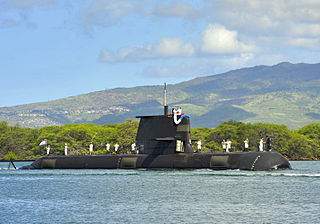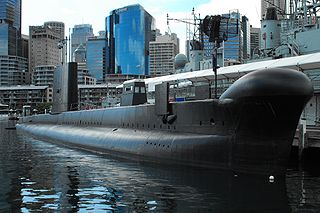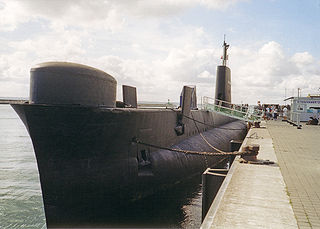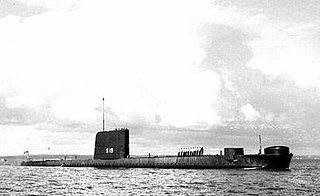
HMAS Newcastle, named for the city of Newcastle, New South Wales, the largest provincial city in Australia, was an Adelaide-class guided-missile frigate. The last ship of the class to be constructed, Newcastle entered service with the Royal Australian Navy in 1993. During her career, the frigate has operated as part of the INTERFET peacekeeping taskforce, served in the Persian Gulf, and responded to the 2006 Fijian coup d'état. The frigate was decommissioned on 30 June 2019 and transferred to the Chilean Navy on 15 April 2020 and renamed as Capitán Prat.

HMAS Farncomb is the second of six Collins class submarines operated by the Royal Australian Navy (RAN). Named for Rear Admiral Harold Farncomb, the submarine was laid down in 1993 and launched in December 1995—the first submarine to be completely constructed in Australia. A combination of factors led to Farncomb being the only vessel of her class in operational condition in mid-2009.

HMAS Sheean is the fifth of six Collins-class submarines operated by the Royal Australian Navy (RAN).

HMAS Colac (J242/M05), named for the town of Colac, Victoria, was one of 60 Bathurst-class corvettes constructed during World War II, and one of 36 initially manned and commissioned solely by the Royal Australian Navy (RAN).

HMAS Onslow is one of six Oberon-class submarines, decommissioned in 1999 and previously operated by the Royal Australian Navy (RAN). The submarine was named after the town of Onslow, Western Australia, and Sir Alexander Onslow, with the boat's motto and badge derived from Onslow's family heritage. Ordered in 1963, Onslow was laid down at the end of 1967 by Scotts Shipbuilding and Engineering Company in Scotland, launched almost a year later, and commissioned into the RAN at the end of 1969.
HMAS Orion was an Oberon class submarine of the Royal Australian Navy (RAN). One of six submarines ordered by the RAN during the 1960s, Orion, named after the constellation in a break from ship-naming tradition, was built in Scotland and commissioned in 1977. Orion was one of two Oberon-class submarines designed for intelligence gathering and conducted regular patrols in Soviet, Indian and Chinese waters to gather information regarding enemy capabilities.

HMAS Otama was an Oberon-class submarine of the Royal Australian Navy (RAN). Built in Scotland, the submarine was the last of the class to enter service when commissioned into the RAN in 1978. Otama was a specialist, one of two "Mystery Boats", fitted with additional surveillance and intelligence-gathering equipment. Otama was routinely deployed on classified operations to obtain intelligence on Soviet Pacific Fleet vessels and Chinese Navy vessels, and conducted associated coastal surveillance, throughout Asia.

The Oberon class was a ship class of 27 British-designed submarines operated by five different nations. They were designed as a direct follow-on from the Porpoise class: physical dimensions were the same, but stronger materials were used in hull construction, and updated equipment was fitted.

HMAS Stuart was one of six River-class destroyer escorts built for the Royal Australian Navy (RAN). The ship was laid down by the Cockatoo Docks and Engineering Company at Cockatoo Island Dockyard in 1959, and commissioned into the RAN in 1963.

HMAS Arunta is an Anzac-class frigate of the Royal Australian Navy (RAN). The ship, named for the Arrernte people, was laid down in 1995 and commissioned in 1998. Since entering service, Arunta has performed a wide range of duties, including border protection patrols in northern Australian waters, and several deployments to the Persian Gulf.

HMAS Toowoomba is the seventh Anzac-class frigate of the Royal Australian Navy (RAN). She was laid down in 2002 by Tenix Defence and commissioned in 2005.

HMAS Vampire was the third of three Australian-built Daring class destroyers serving in the Royal Australian Navy (RAN). One of the first all-welded ships built in Australia, she was constructed at Cockatoo Island Dockyard between 1952 and 1959, and was commissioned into the RAN a day after completion.

The Australian National Maritime Museum (ANMM) is a federally operated maritime museum in Darling Harbour, Sydney. After considering the idea of establishing a maritime museum, the federal government announced that a national maritime museum would be constructed at Darling Harbour, tied into the New South Wales state government's redevelopment of the area for the Australian bicentenary in 1988. The museum building was designed by Philip Cox, and although an opening date of 1988 was initially set, construction delays, cost overruns, and disagreements between the state and federal governments over funding responsibility pushed the opening to 1991.

HMS Otus was a Royal Navy Oberon-class submarine launched in 1962. She was decommissioned in the early 1990s and is now a naval museum in Germany.

The Royal Australian Navy Submarine Service is the collective name of the submarine element of the Royal Australian Navy. The service currently forms the Navy's Submarine Force Element Group (FEG) and consists of six Collins class submarines.

HMAS Otway was an Oberon-class submarine of the Royal Australian Navy (RAN). One of the first four Oberon-class boats ordered for the RAN, Otway was built in Scotland during the mid-1960s, and commissioned into naval service in 1968. The submarine was decommissioned in 1994. The submarine's upper casing, fin, and stern are preserved at Holbrook, New South Wales.

HMS Opossum (S19) was an Oberon-class submarine in service with the Royal Navy from 1964 to 1993.

HMAS Oxley was an Oberon class submarine of the Royal Australian Navy (RAN).

The Jolly Roger is a symbol that has been used by submarines, primarily those of the Royal Navy Submarine Service and its predecessors. The practice came about during World War I: remembering comments by First Sea Lord Admiral Sir Arthur Wilson, who complained that submarines were "underhanded, unfair, and damned un-English" and that personnel should be hanged as pirates, Lieutenant Commander Max Horton began flying the flag after returning from successful patrols. Initially, Horton's submarine HMS E9 flew an additional flag after each successful patrol, but when there was no room for more, the practice was changed to a single large flag, onto which symbols indicating the submarine's achievements were sewn.



















